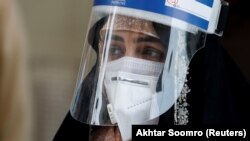
The head of the World Health Organization (WHO) says countries “must stay alert to the possibility of resurgence” as Europe continues to reopen and China faces a fresh coronavirus outbreak that has closed parts of the capital.
As the global number of confirmed coronavirus cases topped eight million and deaths reached 437,000, Tedros Adhanom Ghebreyesus noted that it took over two months to reach 100,000 reported cases -- which is now the daily rate – and the virus is accelerating in Asia and the Americas.
The warning to take action to curb transmission came as China increased testing and lockdowns in parts of the capital on June 16 to contain a new outbreak and New Zealand reported its first new cases in almost a month.
Across Beijing, 29 residential communities have been put under "closed management,” with all entry points guarded and strict controls on individuals leaving or entering amid fears of a second wave of infections after the Chinese capital went more than 50 days without a new case.
Since June 12, a cluster of 106 new infections has been traced to a wholesale market responsible for 80 percent of the capital’s food.
The new cluster highlights how difficult it will be to stamp out the virus, which emerged in China late last year but was largely brought under control with one of the world’s strictest lockdowns.
In New Zealand, which has recorded only 22 deaths among a population of five million and declared last week it had eliminated communitytransmission, two recent arrivals from Britain tested positive after being released early from quarantine to visit a dying relative.
Europe, meanwhile, continues to reopen despite warnings that the coronavirus could make a comeback.
Europe was once the hardest-hit continent, but new cases, hospitalizations, and deaths have declined dramatically.
Many European countries reopened their borders to travelers from other European countries on June 15 after three-months of restrictions.
Germany, Belgium, France, Greece, and the Czech Republic reopened their borders, after Italy did so earlier in June.
The border reopening impacts mostly citizens of the European Union, Britain, and the rest of Europe’s usually passport-free Schengen travel area.
Still, each country is implementing different rules, including testing requirements, quarantines, and specific travel advice or restrictions for individual countries and regions.
For now, visitors from outside the continent will have to wait to enter Europe.
In the United States, about 20 states that began reopening their economies in recent weeks are recording record numbers of new confirmed infections. This is in part attributable to greater testing, but also what health experts say is states reopening.
About a half dozen states are also seeing steadily rising hospitalizations, including Texas, Arizona, and Florida.
The total case count for the United States is around 2.1 million infections and more than 116,000 deaths. According to an updated forecast used by the government, there may be over 200,000 deaths due to COVID-19 in the United States through the beginning of October.
Latin America remains at the center of the pandemic, with more than 80,000 COVID-19 deaths in the region. Brazil carries the unenviable title of second-worst hit in the world with more than 888,000 confirmed cases and some 44,000 deaths.
Despite the virus showing few signs of abating, reopening continues in Mexico and Brazil.
Densely populated India, Pakistan, and Egypt are registering record daily counts of new infections, while Turkey is again seeing rising numbers that the government says could result in new lockdown measures.
In India, the health-care system is starting to buckle as hospital beds fill up.
New infections are rising at over 10,000 a day to top 330,000. Real figures are likely higher.
With reporting by AFP, AP, dpa, and Reuters








